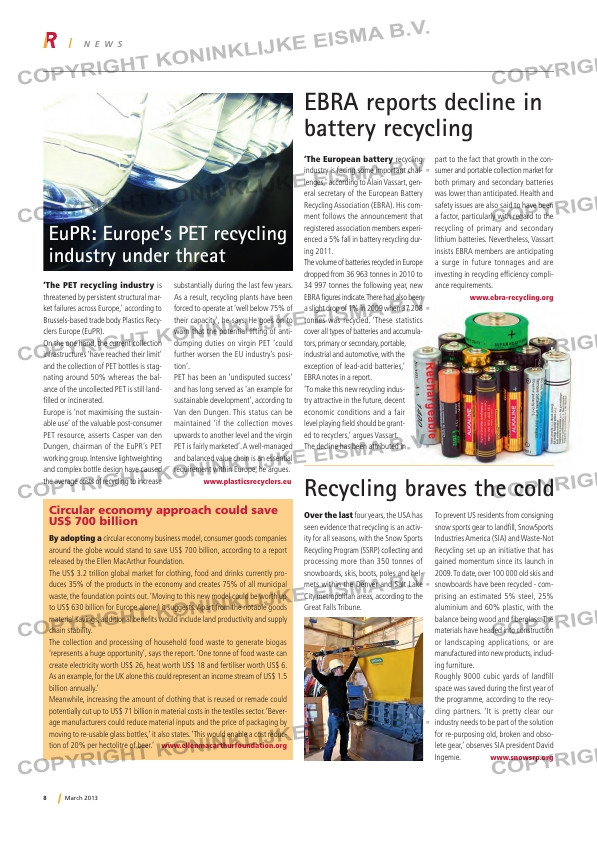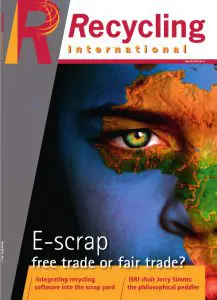Page 8 from: March 2013

8 March 2013
N E W S
‘The PET recycling industry is
threatened by persistent structural mar-
ket failures across Europe,’ according to
Brussels-based trade body Plastics Recy-
clers Europe (EuPR).
On the one hand, the current collection
infrastructures ‘have reached their limit’
and the collection of PET bottles is stag-
nating around 50% whereas the bal-
ance of the uncollected PET is still land-
fi lled or incinerated.
Europe is ‘not maximising the sustain-
able use’ of the valuable post-consumer
PET resource, asserts Casper van den
Dungen, chairman of the EuPR’s PET
working group. Intensive lightweighting
and complex bottle design have caused
the average costs of recycling to increase
substantially during the last few years.
As a result, recycling plants have been
forced to operate at ‘well below 75% of
their capacity’, he says. He goes on to
warn that the potential lifting of anti-
dumping duties on virgin PET ‘could
further worsen the EU industry’s posi-
tion’.
PET has been an ‘undisputed success’
and has long served as ‘an example for
sustainable development’, according to
Van den Dungen. This status can be
maintained ‘if the collection moves
upwards to another level and the virgin
PET is fairly marketed’. A well-managed
and balanced value chain is an essential
requirement within Europe, he argues.
www.plasticsrecyclers.eu
EuPR: Europe’s PET recycling
industry under threat
‘The European battery recycling
industry is facing some important chal-
lenges,’ according to Alain Vassart, gen-
eral secretary of the European Battery
Recycling Association (EBRA). His com-
ment follows the announcement that
registered association members experi-
enced a 5% fall in battery recycling dur-
ing 2011.
The volume of batteries recycled in Europe
dropped from 36 963 tonnes in 2010 to
34 997 tonnes the following year, new
EBRA fi gures indicate. There had also been
a slight drop of 1% in 2009 when 37 208
tonnes was recycled. ‘These statistics
cover all types of batteries and accumula-
tors, primary or secondary, portable,
industrial and automotive, with the
exception of lead-acid batteries,’
EBRA notes in a report.
‘To make this new recycling indus-
try attractive in the future, decent
economic conditions and a fair
level playing fi eld should be grant-
ed to recyclers,’ argues Vassart.
The decline has been attributed in
part to the fact that growth in the con-
sumer and portable collection market for
both primary and secondary batteries
was lower than anticipated. Health and
safety issues are also said to have been
a factor, particularly with regard to the
recycling of primary and secondary
lithium batteries. Nevertheless, Vassart
insists EBRA members are anticipating
a surge in future tonnages and are
investing in recycling effi ciency compli-
ance requirements.
www.ebra-recycling.org
EBRA reports decline in
battery recycling
Over the last four years, the USA has
seen evidence that recycling is an activ-
ity for all seasons, with the Snow Sports
Recycling Program (SSRP) collecting and
processing more than 350 tonnes of
snowboards, skis, boots, poles and hel-
mets within the Denver and Salt Lake
City metropolitan areas, according to the
Great Falls Tribune.
To prevent US residents from consigning
snow sports gear to landfi ll, SnowSports
Industries America (SIA) and Waste-Not
Recycling set up an initiative that has
gained momentum since its launch in
2009. To date, over 100 000 old skis and
snowboards have been recycled – com-
prising an estimated 5% steel, 25%
aluminium and 60% plastic, with the
balance being wood and fi berglass. The
materials have headed into construction
or landscaping applications, or are
manufactured into new products, includ-
ing furniture.
Roughly 9000 cubic yards of landfill
space was saved during the fi rst year of
the programme, according to the recy-
cling partners. ‘It is pretty clear our
industry needs to be part of the solution
for re-purposing old, broken and obso-
lete gear,’ observes SIA president David
Ingemie. www.snowsrp.org
Recycling braves the cold
By adopting a circular economy business model, consumer goods companies
around the globe would stand to save US$ 700 billion, according to a report
released by the Ellen MacArthur Foundation.
The US$ 3.2 trillion global market for clothing, food and drinks currently pro-
duces 35% of the products in the economy and creates 75% of all municipal
waste, the foundation points out. ‘Moving to this new model could be worth up
to US$ 630 billion for Europe alone,’ it suggests. Apart from the notable goods
material savings, additional benefi ts would include land productivity and supply
chain stability.
The collection and processing of household food waste to generate biogas
‘represents a huge opportunity’, says the report. ‘One tonne of food waste can
create electricity worth US$ 26, heat worth US$ 18 and fertiliser worth US$ 6.
As an example, for the UK alone this could represent an income stream of US$ 1.5
billion annually.’
Meanwhile, increasing the amount of clothing that is reused or remade could
potentially cut up to US$ 71 billion in material costs in the textiles sector. ‘Bever-
age manufacturers could reduce material inputs and the price of packaging by
moving to re-usable glass bottles,’ it also states. ‘This would enable a cost reduc-
tion of 20% per hectolitre of beer.’ www.ellenmacarthurfoundation.org
Circular economy approach could save
US$ 700 billion
RI_2-NEWS.indd 8 06-03-13 09:35



